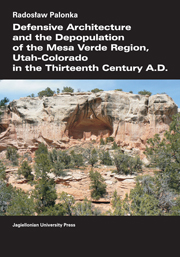Book contents
- Frontmatter
- Dedication
- Contents
- List of Figures
- Acknowledgments
- CHAPTER I Introduction
- CHAPTER II Mesa Verde region – definition, natural environment, history and methodology of research
- CHAPTER III Defining and interpreting defensive architecture
- CHAPTER IV Ethnography, ethnohistory, and Native American oral traditions concerning defensive architecture and conflicts in the Southwest
- CHAPTER V Analysis of the central Mesa Verde region architecture in the thirteenth century A.D.
- CHAPTER VI Summary and conclusions
- REFERENCES
- PHOTOGRAPHS
CHAPTER I - Introduction
Published online by Cambridge University Press: 05 September 2014
- Frontmatter
- Dedication
- Contents
- List of Figures
- Acknowledgments
- CHAPTER I Introduction
- CHAPTER II Mesa Verde region – definition, natural environment, history and methodology of research
- CHAPTER III Defining and interpreting defensive architecture
- CHAPTER IV Ethnography, ethnohistory, and Native American oral traditions concerning defensive architecture and conflicts in the Southwest
- CHAPTER V Analysis of the central Mesa Verde region architecture in the thirteenth century A.D.
- CHAPTER VI Summary and conclusions
- REFERENCES
- PHOTOGRAPHS
Summary
This book is a shortened and updated version of the doctoral dissertation that was completed and defended by the author in 2009. The main objective of the book is to examine cultural situation in the thirteenth century A.D. in the central portion of the Mesa Verde region, located in southwestern Colorado and southeastern Utah, and analyze selected sites from the area in terms of location and architectural features that may suggest that these settlements were constructed for defensive purposes. The central Mesa Verde region is well known to archaeologists and many tourists because of the famous cliff dwellings in the alcoves of the sandstone canyons of Mesa Verde National Park. These ancient Puebloan villages were constructed and inhabited mostly during the late Pueblo III period (ca. 1225–1300 A.D.); however, Ancestral Puebloan occupation of the area began many centuries before, in the first millennium B.C. (Charles 2006; Cordell 1997; Lipe 1999b). The late Pueblo III period was a time of many changes and reorganization in the ancient Pueblo world that are apparent in both the remaining architecture and the artifact assemblages in the Mesa Verde region. Socio-cultural changes probably occurred as well. The late Pueblo III period was a time of peak population in the region and, near the end of the thirteenth century A.D., of final depopulation and emigrations from the area.
This book consists of six chapters. The first is an introductory chapter that presents the objectives and scope of the book.
- Type
- Chapter
- Information
- Defensive Architecture and the Depopulation of the Mesa Verde Region, Utah-Colorado in the Thirteenth Century AD , pp. 15 - 18Publisher: Jagiellonian University PressPrint publication year: 2011



